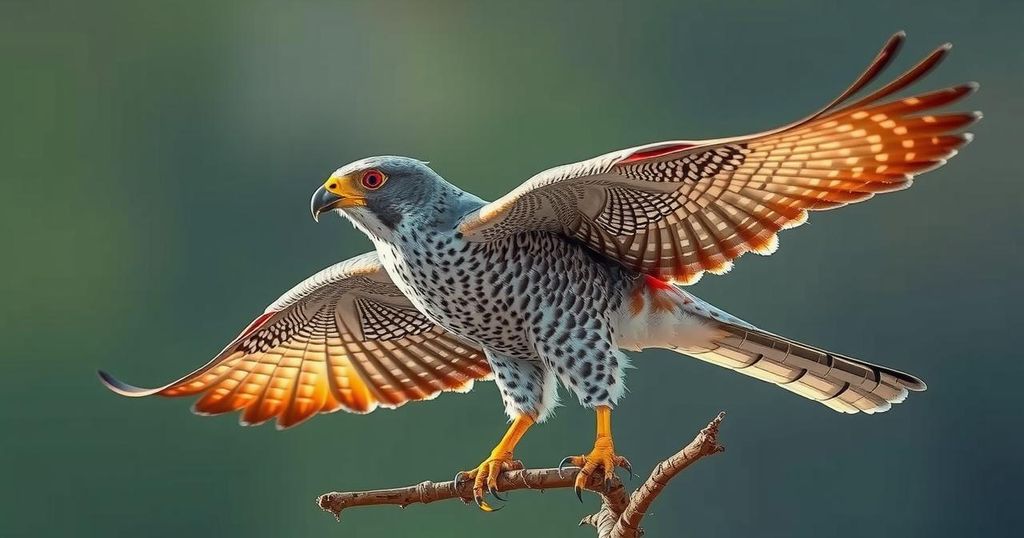Satellite-Tagged Amur Falcon Completes Journey to Somalia-Kenya Border

Chiuluan 2, a satellite-tagged Amur falcon from Manipur, has successfully reached the Somalia-Kenya border following a journey from Maharashtra. Tracking these birds, facilitated by the Wildlife Institute of India and local efforts, aims to illuminate their migratory habits. Meanwhile, another falcon, Guangram, remains in its original roosting site, highlighting the ongoing conservation efforts for these birds, recognized for their extensive annual migration spanning approximately 20,000 kilometers.
Chiuluan 2, one of two satellite-tagged Amur falcons released from Tamenglong district in Manipur, has successfully reached the Somalia-Kenya border following a notable journey across the Arabian Sea. According to Senior Scientist R. Suresh Kumar from the Wildlife Institute of India, the male falcon commenced its journey from Guhagar in Maharashtra’s Ratnagiri district on Sunday at 10:30 AM and arrived in Somalia by Tuesday evening. As of Friday, it was located near the Somalia-Kenya border. Another satellite-tagged falcon, Guangram, remains at the roosting site in Tamenglong, showcasing the divergent paths of the two tagged birds. The tagging and monitoring of Amur falcons aims to track their migratory behavior and the various environmental factors influencing their routes.
On November 8, the release of the two Amur falcons was a collaborative effort involving the Manipur Forest Department, the Wildlife Institute of India, and local villagers. The initiative not only highlights the importance of studying these magnificent birds but also raises awareness about their migratory patterns. On the same occasion, nine additional Amur falcons were released following being ringed for tracking purposes. Named after key roosting villages in Manipur, Chiuluan and Guangram’s release marks a significant step towards conservation efforts.
Known locally as ‘Akhuaipuina,’ the Amur falcon is recognized as the world’s longest-traveling bird, undertaking an annual migration that covers approximately 20,000 kilometers. These raptors breed in Southeast Russia and Northeast China during the summer months and migrate to South Africa for winter. Their journey encompasses multiple stopovers, including regions in Northeast India and Somalia. They typically arrive in India around October, roosting in areas such as Nagaland and Manipur, where they prepare for their extensive flight to Africa in November.
The Amur falcon is noted for its remarkable migratory journey, being among the longest-traveling birds globally. Protected under the Wildlife Protection Act of 1972 in India, these birds are emblematic of wilderness and conservation efforts. Migration for them is vital, as they travel from breeding grounds in Southeast Russia and Northeast China to wintering areas in South Africa, covering around 20,000 kilometers annually. Their migratory path often includes critical stopovers, which are essential for their feeding and energy recovery before continuing their journey. Conservation efforts, including research and tracking through tagging, are crucial for understanding their migratory routes and environmental interactions, demonstrating a commitment from local communities and authorities to protect these species and their habitats.
The migration of Chiuluan 2 to the Somalia-Kenya border underscores the significance of ongoing conservation initiatives for the Amur falcon. The collaboration between various stakeholders in Manipur highlights the dedication to studying and protecting these remarkable birds and their migratory routes. As Chiuluan 2 progresses on its journey, it symbolizes the importance of environmental stewardship and the commitment to safeguarding wildlife in India and beyond. Monitoring these migrations will enhance our understanding of avian behavior and the challenges these birds face in their natural habitats.
Original Source: www.eastmojo.com







